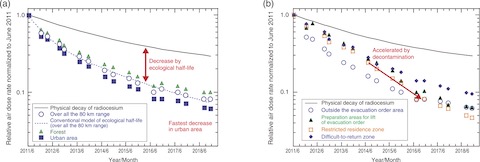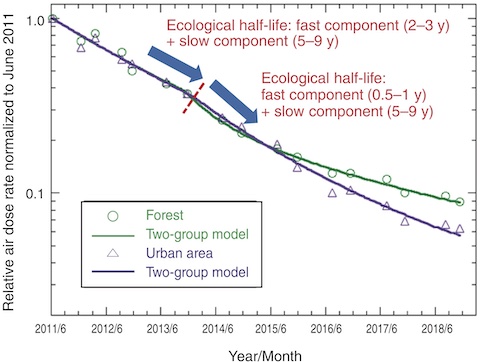
Fig.1-28 Decreasing trend in air dose rates by the car-borne surveys within 80 km of 1F

Fig.1-29 Comparison of air dose rates between the measured values and those of the two-group model
After TEPCO's Fukushima Daiichi NPS (1F) accident, we performed a series of measurements of the air dose rates using car-borne surveys to evaluate the air dose rate distribution and to obtain basic data for decisions on lifting the evacuation orders. The measurements were carried out using the Kyoto University RAdiation MApping (KURAMA) system developed by the Kyoto University Research Reactor Institute. The KURAMA system consists of radiation measuring equipment installed in ordinary cars, which survey air dose rates continuously along the road.
We have analyzed a huge amount of air dose rate data to precisely evaluate its temporal change. Air dose rates decrease due to physical decay of radiocesium and environmental effects such as weathering and decontamination. Ecological half-lives are parameters that model the decreases in the air dose rate due to environmental effects other than the physical decay of radionuclides. A conventional bi-exponential model of ecological half-life describes the decrease in the air dose rates with fast and slow decreasing components (short and long half-lives, respectively).
The ratio of the air dose rate in November 2018 to that in June 2011 measured over all the regions within 80 km of 1F, where the influence of radiocesium emitted by the accident was relatively significant, was evaluated as 0.08 (see circles in Fig.1-28(a)). This ratio is very small compared with that predicted from the physical decay of radiocesium (0.29; see the solid line in Fig.1-28(a)). This difference is due to the ecological half-lives, and the conventional bi-exponential model describes the decrease in air dose rates as the dashed line in Fig.1-28(a). This figure also shows that the decreasing rate is lowest in the forest and highest in the urban area, which is a result of human activities.
The decreasing trend of the air dose rates depends on the types of the areas as shown in Fig.1-28(b). Decontamination works have been actively carried out in the preparation areas for lift of evacuation order and in the restricted residence zone, where the decrease in the air dose rates accelerated after 2013. As a result, there is a significant difference from the decreasing trend of the difficult-to-return zone. In such a case, the conventional bi-exponential model could not represent the temporal changes in air dose rates well. Therefore, we newly introduced the two-group model where the fast component of the ecological half-life is shortened by the effect of the decontamination works. We applied this model to the preparation areas for lift of evacuation order and obtained the values of 0.5-1 y for the ecological half-life of the fast-decreasing components after the year 2013, which was significantly shorter than the values of 2-3 y obtained before 2013. The two-group model improved the evaluation of the fast component, and the curves of the decrease in the air dose rate obtained from the model are in good agreement with the measured data as shown in Fig.1-29. These results visualize the effect of decontamination and are expected to be used in future studies such as decontamination planning or cancellation of evacuation orders.
This study was a part of the results of the consignment project conducted on “Aggregation of radioactive material distribution data associated with TEPCO Fukushima Daiichi Nuclear Power Station accident in FY2018”, supported by the Nuclear Regulation Authority (NRA), Japan.
(Masaki Andoh)